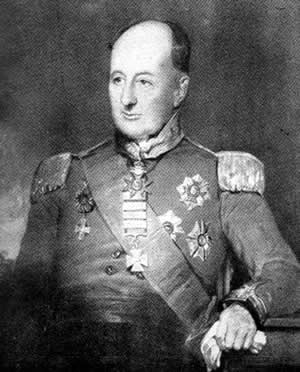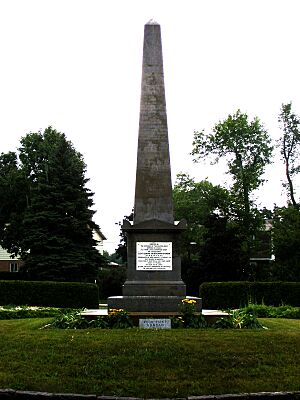Benjamin D'Urban facts for kids
Quick facts for kids
Sir Benjamin D'Urban
|
|
|---|---|

Sir Benjamin D'Urban
|
|
| Birth name | Benjamin D'Urban |
| Born | 16 February 1777 Halesworth, Suffolk |
| Died | 25 May 1849 (aged 72) Montreal, Canada East |
| Allegiance | |
| Service/ |
|
| Years of service | 1793–1849 |
| Rank | Lieutenant General |
| Commands held | British troops in Canada |
| Battles/wars | Napoleonic Wars |
| Awards | Knight Grand Cross of the Order of the Bath Knight Commander of the Royal Guelphic Order |
Lieutenant General Sir Benjamin D'Urban GCB KCH FRS (1777–1849) was a British general and colonial leader. He is best known for his work as Governor of the British Cape Colony in what is now South Africa. He played a big role in shaping the borders and policies of the colony during his time there.
Contents
Early Military Career
Benjamin D'Urban was born in Halesworth, England, in 1777. He joined the British Army when he was just 16 years old in 1793. He quickly moved up in rank.
He became famous during the Peninsular War (1807–1814). This was a major conflict in Europe. D'Urban worked closely with a top general, William Carr Beresford. He helped plan battles and manage supplies.
D'Urban fought in many important battles and sieges. He earned many awards for his bravery and service. These included the Knight Grand Cross of the Order of the Bath. He also received the Army Gold Medal for his actions in several major battles. These battles included Busaco, Albuera, and Salamanca.
At the Battle of Salamanca in 1812, D'Urban led a group of Portuguese cavalry (soldiers on horseback). His troops did very well, helping to attack the French army.
Leading in Other Countries
After his military success, D'Urban began a career as a colonial governor. In 1819, he became the Governor of Antigua, an island in the Caribbean.
Later, in 1824, he became the Lieutenant Governor of Demerara Essequibo. This area is now part of Guyana. In 1831, he helped combine this area with another colony called Berbice. Together, they formed British Guiana. D'Urban became its first governor.
Three years later, in 1834, he was chosen to be the Governor of the British Cape Colony in South Africa.
Governor of the Cape Colony
As governor in South Africa, D'Urban faced many challenges. One big event was the Great Trek. This was when many Dutch farmers moved away from the colony. They went to new lands in the north and east.
There were also conflicts with the local Xhosa people. These clashes led to the Xhosa Wars (1834–1835). D'Urban's actions led to the British taking more land. This land was between the Keiskamma River and the Great Kei River.
During his time, the British government also ended slavery in the colony. New local councils were set up. The British also took control of Natal, naming it a new colony. To honor D'Urban, the main port in Natal was renamed Durban in 1835.
Political Challenges
Even though D'Urban was popular with the white settlers, his policies towards the Xhosa people caused problems. A missionary named John Philip spoke out against D'Urban's actions. He went to England to share his concerns with the government.
This led to public discussion and concern. As a result, the colonial secretary, Charles Grant, decided to remove D'Urban from his post. D'Urban left his role as governor in 1838. However, he continued to serve in the military in South Africa until 1846.
Later Life and Legacy
In 1847, Sir Benjamin D'Urban took on a new role. He became the commander of the British forces in British North America (now Canada). He set up his headquarters in Montreal.
He stayed in Montreal until his death in 1849. He was first buried in a military cemetery there. Later, his remains were moved to the National Field of Honour. This is a military cemetery in Pointe-Claire, Canada.
An obelisk (a tall, four-sided pillar) stands there in his memory. It has plaques that tell his story. One plaque was donated by the City of Durban in South Africa. This shows his lasting impact around the world.
See also
 In Spanish: Benjamin D'Urban para niños
In Spanish: Benjamin D'Urban para niños
| Government offices
|
||
|---|---|---|
| Preceded by George William Ramsay |
Governor of Antigua 1819–1826 |
Succeeded by Sir Patrick Ross |
| New creation | Governor of British Guiana 1831–1833 |
Succeeded by James Carmichael Smyth |
| Preceded by Sir Lowry Cole |
Governor of the Cape Colony 1834–1838 |
Succeeded by Sir George Thomas Napier |
| Military offices | ||
| Preceded by The Earl Cathcart |
Commander-in-Chief, North America 1847–1849 |
Succeeded by Sir William Rowan |
| Preceded by Sir Thomas Hislop, 1st Baronet |
Colonel of the 51st (2nd Yorkshire West Riding) Regiment of Foot 1829–1849 |
Succeeded by Sir Thomas Willshire, 1st Baronet |


